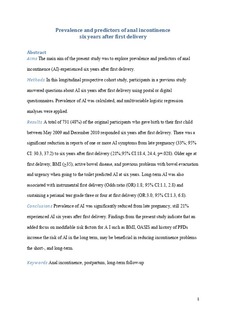| dc.contributor.author | Johannessen, Hege Hølmo | |
| dc.contributor.author | Stafne, Signe Nilssen | |
| dc.contributor.author | Falk, Ragnhild Sørum | |
| dc.contributor.author | Stordahl, Arvid | |
| dc.contributor.author | Wibe, Arne | |
| dc.contributor.author | Mørkved, Siv | |
| dc.date.accessioned | 2019-09-04T08:09:30Z | |
| dc.date.available | 2019-09-04T08:09:30Z | |
| dc.date.created | 2018-11-17T12:02:25Z | |
| dc.date.issued | 2018 | |
| dc.identifier.citation | Neurourology and Urodynamics. 2018, 38 310-3199. | nb_NO |
| dc.identifier.issn | 0733-2467 | |
| dc.identifier.uri | http://hdl.handle.net/11250/2612377 | |
| dc.description.abstract | Aims
The main aim of the present study, was to explore prevalence and predictors of anal incontinence (AI) experienced 6 years after first delivery.
Methods
In this longitudinal prospective cohort study, participants in a previous study answered questions about AI 6 years after first delivery using postal or digital questionnaires. Prevalence of AI was calculated, and multivariable logistic regression analyses were applied.
Results
A total of 731 (48%) of the original participants who gave birth to their first child between May 2009 and December 2010 responded 6 years after first delivery. There was a significant reduction in reports of one or more AI symptoms from late pregnancy (33%; 95%CI: 30.3, 37.2) to 6 years after first delivery (21%; 95%CI:18.4, 24.4, P = 0.028). Older age at first delivery, BMI (≥35), active bowel disease, and previous problems with bowel evacuation and urgency when going to the toilet predicted AI at 6 years. Long‐term AI was also associated with instrumental first delivery (Odds ratio (OR):1.8; 95%CI:1.1, 2.8) and sustaining a perianal tear grade three or four at first delivery (OR:3.0; 95%CI:1.3, 6.8).
Conclusions
Prevalence of AI was significantly reduced from late pregnancy, still 21% experienced AI 6 years after first delivery. Findings from the present study indicate that an added focus on modifiable risk factors for AI such as BMI, OASIS and history of PFDs increase the risk of AI in the long term, may be beneficial in reducing incontinence problems the short‐ and long‐term. | nb_NO |
| dc.language.iso | eng | nb_NO |
| dc.publisher | Wiley | nb_NO |
| dc.title | Prevalence and predictors of anal incontinence 6 years after first delivery | nb_NO |
| dc.type | Journal article | nb_NO |
| dc.type | Peer reviewed | nb_NO |
| dc.description.version | acceptedVersion | nb_NO |
| dc.source.pagenumber | 310-3199 | nb_NO |
| dc.source.volume | 38 | nb_NO |
| dc.source.journal | Neurourology and Urodynamics | nb_NO |
| dc.identifier.doi | 10.1002/nau.23854 | |
| dc.identifier.cristin | 1631659 | |
| dc.description.localcode | Locked until 12.10.2019 due to copyright restrictions. This is the peer reviewed version of an article, which has been published in final form at [https://doi.org/10.1002/nau.23854]. This article may be used for non-commercial purposes in accordance with Wiley Terms and Conditions for Self-Archiving. | nb_NO |
| cristin.unitcode | 194,65,20,0 | |
| cristin.unitcode | 194,65,15,0 | |
| cristin.unitname | Institutt for samfunnsmedisin og sykepleie | |
| cristin.unitname | Institutt for klinisk og molekylær medisin | |
| cristin.ispublished | true | |
| cristin.fulltext | preprint | |
| cristin.qualitycode | 1 | |
